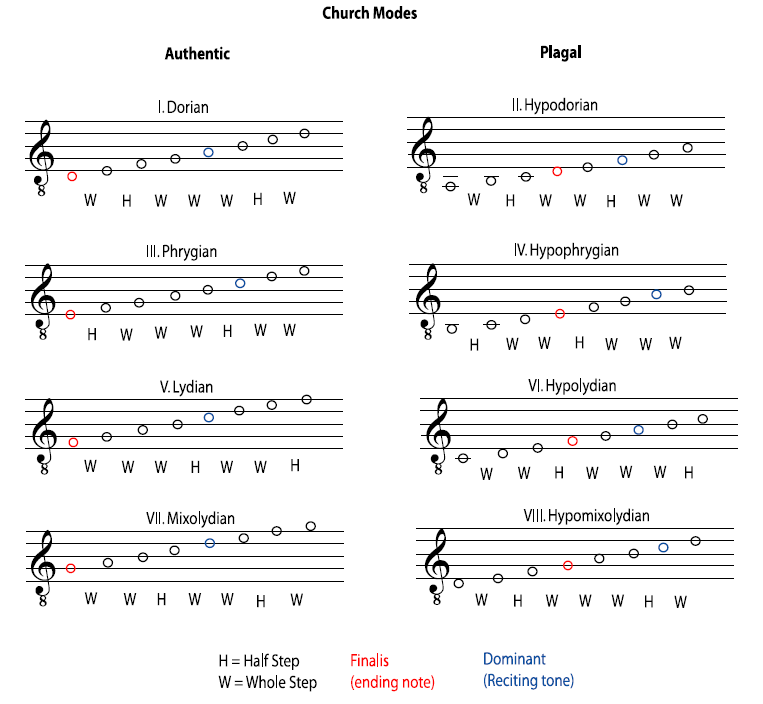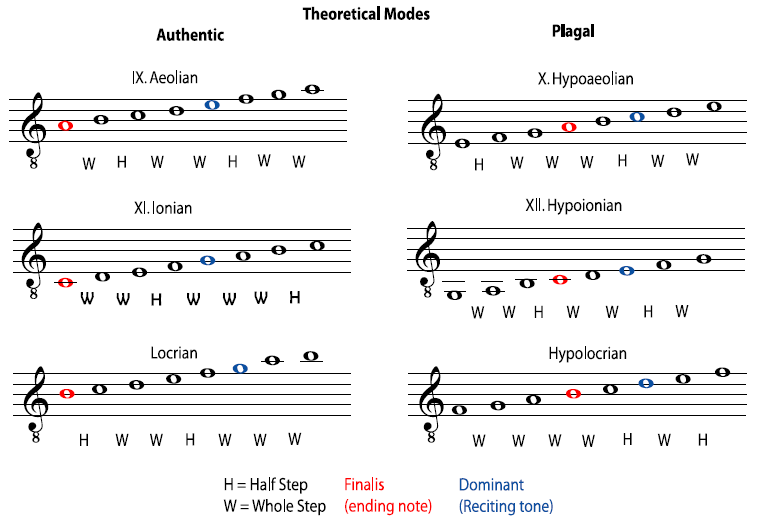Sacred music in the middle ages in Western Europe - Gregorian chant, for example - was also modal, and the medieval Church modes were also considered to have different effects on the listener. (As of this writing the site Ricercares by Vincenzo Galilei22 had a list of the "ethos" or mood associated with each medieval mode.) In fact, the names of the church modes were borrowed from the Greek modes, but the two systems don't really correspond to each other, or use the same name to indicate the same set of intervals. So some books prefer to name the church modes using a Roman numeral system. Each of these modes can easily be found by playing its one octave range, or ambitus, on the "white key" notes on a piano. But the Dorian mode, for example, didn't have to start on the pitch we call a D. The important thing was the pattern of half steps and whole steps within that octave, and their relationship to the notes that acted as the modal equivalent of tonal centers, the finalis and the dominant. Generally, the last note of the piece was the finalis, giving it the same "resting place" function as a modern tonal center. The dominant, also called the reciting tone or tenor, was the note most often used for long recitations on the same pitch.

A mode can be found by playing all the "white key" notes on a piano for one octave. From D to D, for example is Dorian; from F to F is Lydian. Notice that no modes begin on A, B, or C. This is because a B flat was allowed, and the modes beginning on D, E, and F, when they use a B flat, have the same note patterns and relationships as would modes beginning on A, B, and C. After the middle ages, modes beginning on A, B, and C were named, but they are still not considered Church modes. Notice that the Aeolian (or the Dorian using a B flat) is the same as an A (or D) natural minor (pg 131) scale and the Ionian (or the Lydian using a B flat) is the same as a C (or F) major scale.

In our modern tonal system, any note may be sharp, flat, or natural, but in this modal system, only the B was allowed to vary. The symbols used to indicate whether the B was "hard" (our B natural) or "soft" (our B flat) eventually evolved into our symbols for sharps, flats, and naturals. All of this may seem very arbitrary, but it's important to remember that medieval mode theory, just like our modern music theory, was not trying to invent a logical system of music. It was trying to explain, describe, and systematize musical practices that were already flourishing because people liked the way they sounded.

The Tuning used in medieval Europe was also not our familiar Equal Temperament system. It was a just intonation system, based on a pure perfect fifth. In this system, half steps are not all equal to each other. Slight adjustments are made in tuning and intervals to make them more pleasant to the ear; and the medieval ear had different preferences than our modern ears. This is another reason that modes sounded very different from each other, although that particular difference may be missing today when chant is sung using equal temperament.
- 19588 reads






